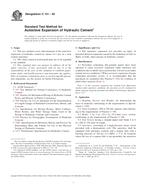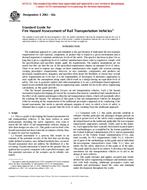1.1 This test method covers the determination of the susceptibility of cement-aggregate combinations to expansive reactions involving hydroxyl ions associated with the alkalies (sodium and potassium) by measurement of the increase (or decrease) in length of mortar bars containing the combination during storage under prescribed conditions of test.
1.2 Alkalies participating in the expansive reactions usually are derived from the cement; under some circumstances they may be derived from other constituents of the concrete or from external sources. Two types of alkali reactivity of aggregates are recognized: (1) an alkali-silica reaction involving certain siliceous rocks, minerals, and natural or artificial glasses and (2) an alkali-carbonate reaction involving dolomite in certain calcitic dolomites and dolomitic limestones (see Descriptive Nomenclature C294). The method is not recommended as a means to detect the latter reaction because expansions produced in the mortar-bar test by the alkali-carbonate reaction (see Test Method C586) are generally much less than those produced by the alkali-silica reaction for combinations having equally harmful effects in service.
1.3 The values stated in SI units are to be regarded as standard. When combined standards are cited, the selection of measurement system is at the user's discretion subject to the requirements of the referenced standard.
1.4 This standard does not purport to address all of the safety concerns, if any, associated with its use. It is the responsibility of the user of this standard to establish appropriate safety and health practices and determine the applicability of regulatory limitations prior to use.
Product Details
- Published:
- 02/01/2010
- Number of Pages:
- 6
- File Size:
- 1 file , 110 KB
- Redline File Size:
- 2 files , 210 KB


